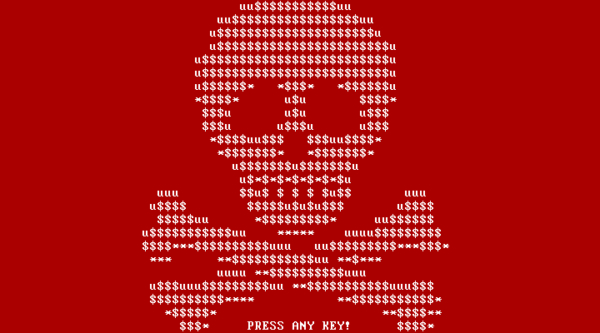 Computer screenshot of the 2017 PETYA malware payload;
Computer screenshot of the 2017 PETYA malware payload;
Now in to the sixth week of the Russian military invasion of Ukraine that commenced on 24 February 2022, any diplomatic solution for a complete ceasefire or withdrawal of Russian troops from Ukrainian territory is not in sight despite the holding of talks with representatives of both sides.
This brings us to the burgeoning questions of what are the next options for Russia, militarily and non-militarily, and what these current developments could mean for the rest of the world?
Russian Stance
On Friday 25 March 2022, Russia's former president and current deputy head of its security council, Dmitry Medvedev, stated that sanctions against Russia would not have any effect on Moscow’s plans. The statement resonates President Vladimir Putin's demand for Ukraine to adopt neutrality and that it should not apply to join the US-led NATO military alliance, acknowledge Crimea as Russian territory and recognise Donetsk and Luhansk as independent states.
Ukraine asserted that it would not compromise on its territory or sovereignty, though it may agree to a neutral status in exchange for security guarantees. Ukraine also sought for a Russian ceasefire.
The uncompromising rhetoric indicates that Russia will continue on its objectives in short- to medium-term, both militarily as well as during the ongoing diplomatic talks in Istanbul this week.
Moscow had earlier protested against the missile deployment by NATO in Poland (scheduled for 2018/2019, missiles are on-site but not operational) and Romania (operational in 2015, upgraded with new missile systems in 2019) and reiterated its perceived threat of the same happening in Ukraine.
In response to NATO missile defence systems being deployed in Poland and Romania, Russia deployed its own missiles and nuclear-capable ballistics in the enclave of Kaliningrad, bordering Poland and Lithuania, in 2016, and completed the formation of a joint air defence system with Belarus in January 2022.
Russia annexed Crimea, a peninsula in the Black Sea, from Ukraine in 2014, although most countries of the world - in a UN resolution of March 2014 – consider Crimea still to be part of Ukraine.
Demilitarise, de-nazify Ukraine
One of the early statements by President Putin in attempting to justify the Russian invasion of Ukraine was to demilitarise and “de-nazify” Ukraine, calls for more attention to try to understand Russia’s concern.
From President Putin’s point of view, Ukraine had been part of the Soviet Union, and the Ukrainian independence movement during World War II involved ethnic Ukrainians who were adversaries aligned with the Nazis. This link is depicted by Russia today as Ukraine being a Nazi nation and therefore Russia is justified to “liberalise” the separatists.
Historically, most of the war between Germany and the Soviet Union during World War II was fought in modern day Ukraine, Belarus and large parts of western Russia.
Sanctions
Since the invasion on 24 February 2022, a volley of export bans and economic sanctions from the European Union (EU), the United States (US), the United Kingdom (UK), Canada and several other countries, including the exclusion of several Russian banks from the international SWIFT financial messaging system which effectively cut-off Russia's access to its foreign currency reserves, led to severe economic and financial limitations for Russia.
Almost immediately, the Russian rouble lost nearly 60% of its value against major world currencies whilst the Moscow Stock Exchange stopped trading on 25 February 2022 after the Moscow Exchange Russia Index (IMOEX) plummeted 33% the previous day. Partial trading resumed on 24 March 2022 but with restrictions and limitations. The Bank of Russia allowed trading in only 33 of the IMOEX index's 50 companies and banned short selling of these securities.
In response, Russia demanded the EU to pay in roubles for its natural gas; this demand will soon be extended for its oil, grain, metals, fertiliser, coal and timber exports. The G7 group of nations, comprising Canada, France, Germany, Italy, Japan, the United Kingdom and the United States, has rejected this demand.
Given that the Russian military has met with heavy resistance from Ukrainian forces to date, Russia is likely to adapt to alternative military and non-military options.
Military offensive
Russia has so far used limited military capabilities against Ukraine, including its superior air power, which some war analysts have found puzzling. It may be possible that Russia is following on its demand to broker Ukraine to pledge neutrality and refrain from joining NATO without attacking aggressively, whilst some analysts find the level of destruction in Mariupol similar to that of the air-assaults carried out in Aleppo (Syria) and Grozny (Chechnya), underscoring that the assaults are on non-military infrastructures.
Civilian casualties and infrastructure destruction remain severe. The UN Refugee Agency has reported that, in the one month since invasion, over 6.5 million people have been displaced inside Ukraine and another 3.7 million people have left the country, representing nearly a quarter of the total 44 million population, whilst the UN Human Rights Commission reported that at least 1,000 civilians have been killed.
Hybrid war
Russia is likely to engage in a hybrid war which typically comprises unconventional tools to flood opposing military and civilians in confusion, diversion and disinformation, in parallel to engaging with military operations. Propaganda and synchronised online media campaigns are faster, cheaper and easier to orchestrate, compared to ground assaults, and can create mass panic and psychological distresses to undermine public resistance. An increase in online media and content of strategic nature and of state propaganda views would require constant vigilance from all actors.
Cyberattacks
Cyberwarfare is not restricted by boundaries and can inflict serious infrastructure and economic damage.
One recent example of cyber-espionage was the 2020 report of data breaches of multiple US federal, state and local agencies, including the Treasury Department, the Department of Justice, the Department of Defence and the Department of Homeland Security. This was achieved using SolarWinds' Orion software, later attributed to a group working for the Russian Foreign Intelligence Service (SVR); however, the Russian government denied any knowledge or involvement.
The data breach was deemed exceptional and the most sophisticated by experts to date in terms of the number of US government agencies and Fortune500 companies being compromised.
In terms of the magnitude of economic loss, a cyberattack in 2017 by an encrypting malware named "NotPetya", primarily targeted to Ukraine but which quickly spread worldwide, was later attributed to a hacking group within the Russian military intelligence organisation GRU; this remains the costliest cyberattack to date with an estimated damage of up to $10 billion.
Together, the magnitude and sophistication may paralyse critical infrastructures within a very short period.
The Cybersecurity and Infrastructure Security Agency (CISA) has issued five advisories since Jan 2022 mentioning targeted cyber activities by Russian state-sponsored actors and warned against targeted cyberattacks against US, EU and other allied countries.
Russia is not immune to cyber attacks as well and, as recently as March 2022, the Russian Federal Air Transport Agency, Rosaviatsia, was hacked by unidentified hackers or cyberagents.
Hypersonic missiles
Hypersonic weapons, as the name suggests, travel between 5 to 25 times the speed of sound (between 1.6 - 8.0 km per second); these are exceptional modern missiles which are very agile in performing in-flight manoeuvres to change trajectory and can even change target; they are also near-impossible to be intercepted mid-flight by current missile defence systems.
Unveiled by President Putin in March 2018, the "Kinzhal hypersonic missiles" are alleged to be used to destroy an underground weapons depot in Deliatyn on 18 March 2022 and a fuel depot in Konstantinovka on 19 March 2022, the first reports of the use of such advanced missiles in the Russia-Ukraine war. The Kinzhal missiles with advanced target-penetration characteristics and speed up to 12 Mach (speed of sound), can destroy heavily armoured or shielded strategic targets.
Several other countries have developed or are developing such missiles, including the United States, China, India, Brazil, the UK and France.
It is likely that we will witness more of these manoeuvrable guided missiles to destroy strategic infrastructures during the ongoing war.
Nuclear threat
Russian forces captured the now closed Chernobyl Nuclear Power Plant on 24 February 2022 and seized control of Europe's largest nuclear power plant at Zaporizhzhia on 4 March 2022.
While there is no clear consensus on why Russian forces took control of the now defunct Chernobyl nuclear power plant, it is possible that the move was simply strategic - as at only 12 km from the Belarus border, any disturbance in nuclear contaminated soil might act as deterrent to Russian troops from advancing from the north. Taking control of Zaporizhzhia nuclear power plant is, however, a strategic move to control more than a fifth of total electricity generated in Ukraine.
Nuclear plants also double as "protection" against any military offensive or missile targeting against Russian troops.
On 28 February 2022, President Putin ordered the Russian strategic nuclear forces on "special alert", for the first time since the end of the Cold War. While an immediate nuclear strike is unwarranted and counterproductive to Russian objectives, the move is most likely a deterrent and in anticipation of a sudden escalation of the situation in the event of NATO or another country getting involved.
Chemical and Biological weapons
While the US and other countries have warned Russia against the use of chemical and biological weapons, a large scale use against civilian targets remain a low possibility due to easy attribution and heavy political fallout. It may, however, remain a possibility for small and targeted objectives.









